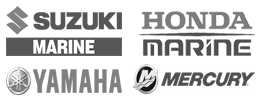Offshore Boats vs Bay Boats: Quick Buyer’s Guide
Making the choice between an offshore boat and a bay boat is almost a rite of passage for a boat buyer. With so many options and choices, there’s no single answer but at the root of the debate, there are a few distinct decision drivers that must be considered before stroking a check.
Blue Water or Coastal Runs?
When buying a car, one consideration is how you’ll use the vehicle. If you’re a highway cruiser going long distances, you might want more comfort like onboard navigation, wifi, satellite radio, heated seats, you know, the works. But if you’re scooting around town on short errands, all those bells and whistles might be costly and overkill. Similarly, you should think about your new boat in the same manner.
If you fancy yourself offshore in blue water catching sportfish for the entire day, it most likely stands to reason that you’ll want an offshore boat over a bay. If you’re planning runs on coastal waters, lounging on a sandbar, or even offshore in fair weather, then a bay boat might be the best boat for your needs. Now let’s look at why…
Offshore Boats In Brief
For starters, an offshore boat will typically be “larger†with respect to footage, console space, and a wide beam. The premise, more boat means you and your passengers have a bit more protection from rough seas in the form of higher freeboard (see: What is nautical freeboard?) and stability. To keep everyone happy and out of the elements, an offshore boat should have a T-Top, in-console head, and we’d recommend entertainment in form of a stereo and easy systems access via a transom door. As for fishing, there’ll be multiple aerated live wells for different baits as well as fish boxes for storing your prized catches. Upfront, “good†offerings will include a windlass and sizeable anchor storage, plenty of compartments, cup holders, charging ports, and comfortable seating throughout. The primary difference between the offshore and the bay boat, you’re prepared to go further out, stay out longer, in less than favorable condition all the while keeping your crew happy.
Bay Boats In Brief
Unlike offshore boats, a bay boat will typically be smaller with respect to its length and width, though not the rule just a statistic, the most common bay is around 22-foot. But smaller doesn’t mean bad, as bay boats often consume less fuel as they are lighter and usually more agile than an offshore. Inside there’ll be lots of similarities like a center console, leaning post or captain’s chairs, cup holders, forward and stern seating, live wells, and ample storage. What might not be obvious, a bay boat will have less freeboard, width, and most include forward and rear casting decks. As for the elements, there’s no rule that says a bay can’t have a top but usually, hardcore coastal anglers decline this option which they may view as an obstruction. Adding to the top must-have bay boat features, versatility shouldn’t be overlooked as this style boat can not only run offshore during good weather but will be able to run shallow due to a smaller draft.
What About Hybrids?
Like automotive crossovers and SUVs, boats have evolved to serve multiple purposes. On the one end, Center Consoles like the LX22 have an appeal for both fishing and family with the versatility to run both offshore and inshore. Likewise, the hybrid bay or bay skiff, such as the Sundance DX series might fit your needs as a “Sport Utility Boatâ€. Before you decide on a final model, be sure to check out the bay boat review of the FX24 and of our family-friendly center consoles.
In the end, there’s no one-size-fits-all answer as just like your last auto purchase, getting down to the needed features and understanding how she’ll be used upfront will not only save time and money but will add to your overall satisfaction.



